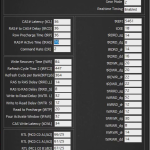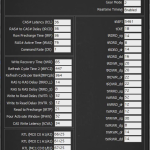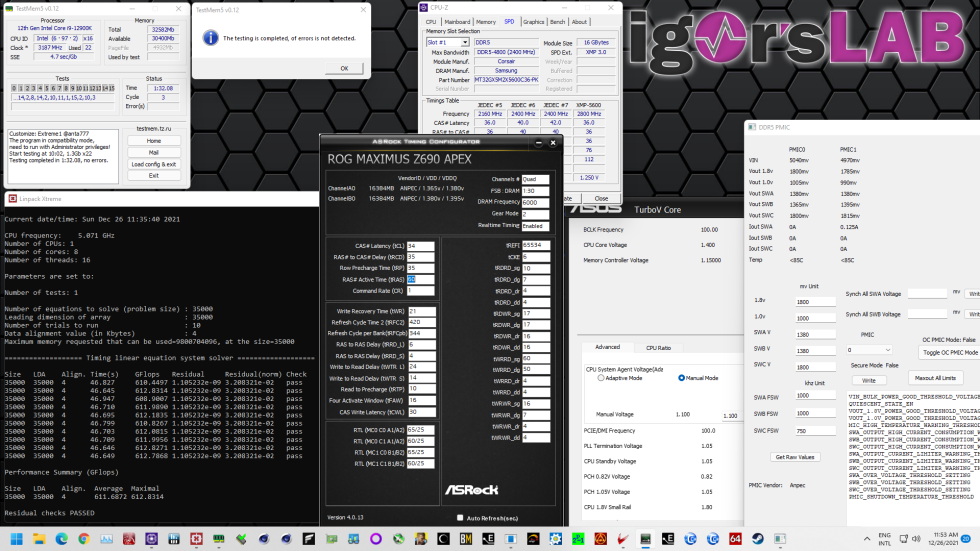XMP compatibility and overclocking
In terms of XMP compatibility, Intel and the motherboard manufacturers frankly still have a few holes to patch. Overclocking forums are full of user reports that kits sometimes do not even run stable in the XMP profile. You can’t just pass the buck to Corsair or other RAM manufacturers here either, because the whole ecosystem around the new standard is simply not mature yet. For example, only the BIOS update from Asus to version 0811 had lowered the auto value of the “MC Voltage” from 1.35 to 1.3 V and thus created a solution for many users with XMP profiles from 6000 Mbps.
Apart from the general teething troubles of the platform, the Corsair kit from today’s test with DDR5-5600 CL36 ran stable on every BIOS release so far. For this, the Asus Maximus Z690 Apex uses 1.2 V “System Agent” and 1.3 V “MC” voltage. The latter stands for Memory Controller, whereby it is a creative renaming on the part of Asus and actually VDD2 is meant according to Intel, or IMC VDD in HWinfo.
On a positive note, the secondary timings are also fully loaded right off the bat, which was often not the case with DDR4. Thus, tWR 84, tRFC2 447, and tRFCpb or tRFC_SB were also set to 364 here. By the way, the latter timing is new for DDR5 and stands for the refresh duration of a single bank (pb = per bank, SB = same bank). I tested the XMP profile once with Command Rate “Auto” = 2T and once with manually set 1T, for which no other adjustments were necessary. You will be surprised how much influence the Command Rate alone can have on the results.
When it comes to manual overclocking, the new “B-Die” is unfortunately not as outstanding as its predecessor when it comes to DDR5 with 16 Gbit capacity. Nevertheless, the clock rate can be increased to DDR5-6000, the subtimings can be increased significantly in some cases and the command rate can be reduced to 1T. Since Gear 1 is currently not possible with DDR5 and Gear 4 has a big latency disadvantage, this is the only reasonable combination of these settings. Even Command Rate 2T, which theoretically allows even higher clock rates in the Gear 2, can’t be stabilized in this case without taking a step backwards in performance.
Without necessarily requiring active cooling, the RAM voltage must be kept below 1.4 V at VDD and VDDQ in my testing, which limits the possible clock rates and timings accordingly. At higher values, the heat causes the first errors after longer stress test runtimes. And even if tighter timings could sometimes be set with this voltage, they are not reliably stable in my tests. Like on Rocket Lake with high RAM clock rates in the Gear 2, the stability partly varies from boot to boot. That means, you start the system e.g. with a setting of 6200 CL32 1T, run through various stability tests like TM5 or LinpackXtreme without errors. Then you restart the system and you can’t reproduce the positive test results anymore – for example, you get the first errors in the TM5 after only a few minutes. After another reboot, the stability changes again, and so on.
I didn’t want to get into this stability gray area with my overclocking for today’s test for the sake of transparency and reproducibility, even though the cause is most likely not the RAM modules themselves. Hopefully Intel will work on this, because even the motherboard manufacturers cannot influence the settings of the memory controllers responsible for this – at least according to my sources.
- 1 - Introduction and unboxing
- 2 - Design and lighting
- 3 - Dimensions, teardown and PCB analysis
- 4 - SPD infos and heatsink performance
- 5 - Test systems and methodology
- 6 - XMP compatibility and overclocking
- 7 - Synthetic benchmarks – AIDA64, GB3, LinpackXtreme, SPI 32M
- 8 - Gaming 1440p – Cyberpunk 2077, SoTR, CSGO
- 9 - Gaming 1080p – Cyberpunk 2077, SoTR, CSGO
- 10 - Summary and conclusion





































8 Antworten
Kommentar
Lade neue Kommentare
Urgestein
Mitglied
Urgestein
Urgestein
Veteran
Urgestein
Mitglied
Mitglied
Alle Kommentare lesen unter igor´sLAB Community →